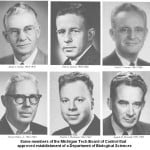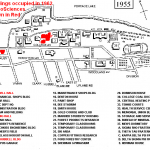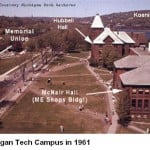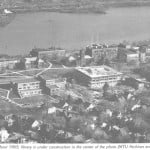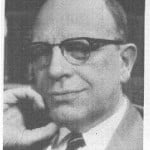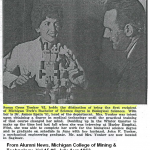![[image R Brown]](https://blogs.mtu.edu/biological/files/2012/08/r_brown.png)
by Robert T. Brown
Written about 1973
At the October 13, 1961 meeting of the Board of Control, it was moved, seconded and passed unanimously, that a Department of Biological Sciences be created as of July 1, 1962, utilizing existing staff members and facilities.
With this action, Robert T. Brown and Kenneth J. Kraft from the Department of Forestry, James D. Spain and Ira H. Horton from the Department of Chemistry and Chemical Engineering, and Robert A. Janke from the Department of Physics were joined into the new department. Brown, Kraft and Janke shared a large office in Hubbell School. Horton continued to occupy his office and laboratory in Koenig Hall.
Spain became Department Head and, with Anita Farrell as secretary, established the Departmental Office in Koenig Hall. After the first year, Susan Yonker had completed all requirements and became the first graduate in Biological Sciences in the Class of 1963.
President Van Pelt vigorously congratulated her and spoke briefly about the establishment of the Department when he presented her diploma. From the single graduate in 1963 the numbers increased greatly as is shown in Table 1 (below). In contrast to the Biological Science majors, the number of Medical Technology graduates shows only moderate growth. Table 1 also shows the number of graduates with the Master of Science degree. The granting of this degree was approved by the Board of Control on February 13, 1965. In the fall of 1965 the first graduate students registered and in 1967, four of them received their degrees. Then as a result of increasing interest in graduate education in Biological Sciences, on June 12, 1970, the Board of Control approved a Ph.D. program.
| Table 1: STUDENT MAJORS GRADUATED | |||||||||||
| 1963 | 1964 | 1965 | 1966 | 1967 | 1968 | 1969 | 1970 | 1971 | 1972 | Total | |
| Med Tech | 10 | 6 | 5 | 5 | 5 | 3 | 11 | 10 | 18 | 5 | 78 |
| Bio Sci | 1 | 5 | 4 | 14 | 14 | 10 | 11 | 27 | 50 | 44 | 180 |
| M. S. | 4 | 2 | 6 | 3 | 3 | 9 | 27 | ||||
| TOTAL | 11 | 11 | 9 | 19 | 23 | 15 | 28 | 40 | 71 | 58 | 285 |
Student enrollments increased more rapidly than did the number of graduates since there is a four-year lag from initial enrollment until graduation. With this enrollment increase shown in Table 2 (below), the need for more faculty became evident. In addition, the retirement of Ira Horton and the departure of Robert Janke to get a Ph.D. required that new people be brought to the campus. Another factor leading to greater enrollment in Biological Science courses was the increasing number of Forestry students who took both requirements and electives in this department. In addition, the training of nursing students in cooperation with St. Joseph Hospital began in 1965 and the establishment of a Biology Teacher Education program began in 1969. Both of these programs raised enrollments in Biological Science.
| Table 2: STUDENT MAJORS ENROLLED | |||||||||||
| Acad Year beginning: | 1962 | 63 | 64 | 65 | 66 | 67 | 68 | 69 | 70 | 71 | 72 |
| BIOLOGICAL SCIENCES | |||||||||||
| Undergraduate | 6 | 21 | 38 | 58 | 59 | 73 | 98 | 141 | 192 | 199 | 222 |
| Special/Unclassified | 0 | 1 | 1 | 0 | 1 | 1 | 1 | 0 | 6 | 1 | 3 |
| Graduate | 0 | 0 | 0 | 6 | 9 | 10 | 8 | 11 | 13 | 19 | 27 |
| TOTAL | 6 | 22 | 39 | 64 | 69 | 84 | 107 | 152 | 211 | 219 | 252 |
| MEDICAL TECHNOLOGY | |||||||||||
| Undergraduate | 42 | 36 | 39 | 59 | 55 | 59 | 68 | 79 | 98 | 130 | 192 |
| Special/Unclassified | 0 | 0 | 0 | 0 | 0 | 0 | 0 | 0 | 1 | 1 | 2 |
| Graduate | 0 | 0 | 0 | 0 | 0 | 0 | 0 | 0 | 0 | 0 | 0 |
TOTAL |
42 | 36 | 39 | 59 | 55 | 59 | 68 | 79 | 99 | 131 | 194 |
| PREMED – PREDENT | |||||||||||
| Undergraduate | 28 | 18 | 19 | 30 | 45 | 49 | 53 | 79 | 90 | 124 | 147 |
| Special/Unclassified | 0 | 0 | 0 | 0 | 0 | 0 | 0 | 0 | 1 | 3 | 1 |
| Graduate | 0 | 0 | 0 | 0 | 0 | 0 | 0 | 0 | 0 | 0 | 0 |
| TOTAL | 28 | 18 | 19 | 30 | 45 | 49 | 53 | 79 | 91 | 127 | 148 |
| GRAND TOTAL | 76 | 76 | 97 | 153 | 169 | 192 | 228 | 310 | 401 | 477 | 594 |
Still another and perhaps even more important factor in the rapid growth of the Department was the public realization of the importance of ecology. The location of the university plus the skills of the faculty made Michigan Tech a most attractive institution in which to study Biological Sciences with an ecological emphasis.
Along with an increasing concern for the environment was also an increasing concern for other humans. This concern led to a large increase in the numbers of Medical Technology majors and Premedical-Predental students, especially in 1971 and 1972. The increasing numbers of both students and faculty as well as the demolition of buildings brought about several changes in the departmental location. Hubbell Hall was renovated and some of its facilities converted so that the department could move out of Hubbell School and Koenig Hall and function as a single unit. Hubbell School was then demolished.
But the need for still larger and more modern facilities quickly became evident. A new building to house Chemistry, Biological Science and Metallurgical Engineering was erected and Biological Sciences moved again. Both Koenig Hall and Hubbell Hall were then demolished and a new building to house the Mechanical Engineering and Engineering Mechanics Department was constructed where they had stood.
By the time the building was completed in 1971, the Biological Sciences Department was too large for the Chemistry-Biological Sciences-Metallurgical Engineering Building so an extensive alteration of the second, tenth and eleventh floors of the new building was carried out to accommodate Biological Sciences. In the fall of 1971, the Department moved into its present location.
The amount of funds obtained from outside sources steadily increased during this period. These grants fell generally into 4 categories:
1. Undergraduate research grants.
2. Undergraduate equipment grants.
3. Faculty research grants.
4. Summer institutes for elementary and secondary teachers.
Undergraduate research grants excited interest in students and also built a base for obtaining larger grants in faculty research. In addition, some rather basic equipment was obtained with this grant money—equipment which could be put to many uses other than that for which it was initially purchased.
Undergraduate equipment grants were used to purchase items necessary for teaching various courses. With these funds, the choice and quality of courses available to students was considerably enhanced.
The faculty research grants enabled scientific investigation by several of the teaching staff. Results have been published in scientific journals and presented at professional meetings. Some of the researchers have been invited to speak at various universities both here and abroad. Students have come here because of interest in particular research topics.
Summer institutes were designed to update pre-college teachers with more modern methods and concepts than they may have been taught when they were in school years before. Not only can they be better teachers; they often influenced their better students to come to Michigan Tech. In addition, two of them returned to obtain their masters degrees here and one of those, Donald Weiss, gave up his position in Philadelphia to teach biology at Houghton High School when the opening appeared.
The Departmental Headship has changed several times during its brief history. Dr. James D. Spain, who served several years in the Department of Chemistry, remained as Head for 6 years from 1962 to 1968. During that time, he consolidated the diverse interests and people into a cohesive functioning department and carried out research on cancer inducing chemicals with the aid of several research grants. For this research, he received the Faculty Research Award in 1965. He chose to retire from the Headship in 1968 because of his increasing interest in Lake Superior research. He has continued with aquatic research projects and in addition, has carried out pioneering work on the use of desk-top computers for mathematical modeling of biological processes. During this beginning phase of the department, the number of faculty members increased from 5 to 10 and the number of students from 76 to 228.
Dr. Spain was replaced as Head by Dr. John Slater who came from the University of California in Berkeley where he had been involved in research on the effects of nuclear radiations on living organisms as well as the influence of weightlessness on various life processes in satellites. In addition, he was involved in writing an elementary biology text book. During his 2-year tenure, he continued his radiation experiments and wrote many chapters in his book. He succeeded in approximately doubling the funds available to the department for teaching and research but he had disagreements with the administration and in 1970, departed to the State University of New York at New Paltz. During this 2-year period, one new faculty member was added and student numbers increased from 228 to 401.
Dr. Slater was replaced in 1970 by Dr. Robert C. Stones who came in 1964 from Purdue University where he had begun research on hibernation in bats. He continued this research and in 1968 he received the Faculty Research Award. Dr. Stones received several National Science Foundation grants to carry out this re-search. He appeared on the nationwide NBC-TV program “Animal Secrets” in 1967 and presented his bat research. During his first two years as Department Head, the number of faculty increased by one and the number of students from 401 to 594.
The secretarial staff also underwent several changes. Anita Farrell remained a secretary for nearly the first seven years. Her knowledge of what a good secretary should do, of how to organize an office and her ability to keep most people happy with her work most of the time aided greatly in these initial years. In the spring of 1969 she was replaced by a “revolving door” through which walked Linda Brylla, Patricia Andrews, Linda Burrus, Karen Van Kley, until at the beginning of 1973, Susan Bailey and Judith Drewyor were the secretaries. Several part-time people also came and went.
Some of the highlights in the careers of faculty members, in order of seniority, follow.
When the Department was formed in 1962, Ira Horton was very close to retirement. For many years, he had been in charge of the Medical Technology program. His experience and steady guidance were invaluable during these first years.
Robert Janke, who transferred from the Department of Physics, continued his biological education by studying for and receiving his Ph.D. in Botany from the University of Colorado. He has spent many summers carrying out ecological research on Isle Royale National Park supported by Park Service grants. He and his wife, Nadine, published “Flora of Isle Royale”, an illustrated guide to flowering plants of the island. He has also published scientific papers concerned with Biophysics and Plant Ecology.
Robert Brown carried out studies on allelopathic relationships in jack pine forests with the aid of a Sigma Xi grant and two National Science Foundation grants. This research led to a Fullbright Fellowship in 1971-72 (16 months) in Finland. He was one of 33 botanists from all parts of the world invited to a conference on allelpathy in 1968, supported by the International Biological Program. In 1972 he gave several lectures at the University of Kiev under sponsorship of the Soviet Academy of Science. Dr. Brown also obtained several grants for summer institutes of pre-college teachers. These institutes led to an assignment as an educational consultant by the Agency for International Development in India in 1968 (2-1/2 months).
Kenneth Kraft obtained National Science Foundation support for a research grant to study the jack pine cone moth. After concluding this study, he shifted his interests to aquatic insects and has since received several grants for the study of the influence of stream pollution from iron mines on aquatic insects. Dr. Kraft also obtained grants for undergraduate research and for undergraduate teaching equipment. These enabled the strengthening of the entire program. In addition, Dr. Kraft was invited to spend a year In Washington D.C. as an administrator in the National Science Foundation. While there, he met and married his wife Elizabeth (Susie).
Frederic Erbisch has long been interested in lichenology and more recently In radiation cell biology as well as metal fungicide compounds. He has received grants to screen metal fungicides, gamma irradiation of lichens and revegetation of copper stamp sands. He joined the faculty in 1963. Dr. Erbisch has also received an undergraduate research grant as well as a grant to develop an audiotutorial system in Biology. Both of these helped to improve the Biology program at Michigan Tech.
In 1966 Jack Holland replaced Dr. Horton as the director of the Medical Technology program. He continued to work on his Ph.D. while teaching in Biological Sciences and received that degree in Chemistry at Michigan Tech in 1968. His thesis dealt with investigations of bile acids in normal and precancerous rats. He also investigated various blood factors in hibernating and non-hibernating woodchucks. In addition, Dr. Holland received several Health, Education and Welfare grants for improvement of the Medical Technology program.
After Dr. Horton retired, Gloria RaIl (1964) and then Bruce Porter (1968) taught microbiology courses. Neither remained here long.
Betzabe Allison joined the faculty in 1967. Her primary research interests concerned aging in Tetrahymena and humans. She received a Fulbright Fellowship to lecture and do research in Peru in 1971-72. She and Eunice Carlson both have long been advocates of equal rights for women and have devoted considerable effort to this cause.
Carl Moyer, a physician, became an adjunct professor in 1967. His special skill was in the treatment of burn victims, especially with silver nitrate. He taught a few classes and then became Director of Research. A short time later, he built the Moyer Clinic between Houghton and Baraga, but then he died suddenly.
In 1970, Eunice Carlson became the microbiologist. Her primary interest was (and still is today) in the area of microbial ecology and viruses as well as genetics of these organisms. She has received grants to study these organisms.
In 1970, Thomas Wright joined the faculty as a part of the aquatic biology program. His research included the revegetation of copper stamp sands, the influence of copper ions in water upon sauger (a fish similar to wall-eyed pike) and nutrient relationships in aquatic systems.
